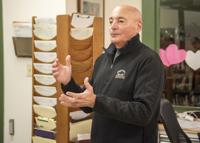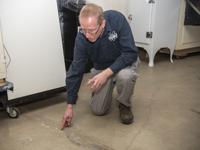In July 1968, just after The Schenectady Museum’s collections were moved into the new hillside location above Nott Terrace, the building flooded. A major rainstorm brought in mud and an inch of water, saturating hundreds of boxes not yet put on shelves.
Textiles were destroyed. Rocks and minerals had to be scrubbed and reorganized, according to Daily Gazette archives of the flood. The cleanup effort took staff and community helpers roughly four years.
That story now feels like a prophecy.
In its half century of existence, the building of the Museum of Innovation and Science, as the museum came to be called in 2012 to reflect its broader focus, has dealt repeatedly with water issues.
A 1998 water main break pooled several inches in the basement.
Hurricane Irene in 2011 flooded classrooms with stormwater.
The building’s roof began to leak in 2016.
And last year’s downright biblical rains overwhelmed a French drain installed in 2017, once again leading to standing water deep enough to soak shoelaces just steps from the museum’s invaluable archives and artifacts, which include 10,000 patents and 2 million photos pertaining to the history of the electrical industry and General Electric.

William Sweet, president of W.R. Sweet & Co., and a trustee member of MiSci, talks about the challenges facing the organization and its facility, in the basement area that houses artifacts within the building.
Further compounding the concern, humidity in the basement spiked to 85% last summer, and cracks in the floor have formed beneath collections of everything from old toasters and fans to a bright red 1947 Soap Box Derby Car painted with “Schenectady Gazette” in white letters. The threat of mold begins when humidity reaches 65%, according to Chris Hunter, vice president of Collections and Exhibitions, who has been with the museum for more than two decades.
As a result, museum leaders, including President Gina Gould, concluded last summer that the time had come to relocate.
It may very well be the right call for a variety of reasons given the current compromised state of the building, as well as visions for the museum’s future that include expanding its footprint.
But as decision makers contemplate what’s next, both museum leaders and elected officials must prioritize keeping the former Schenectady Museum in Schenectady County.
If local representatives are serious about this cause, they will have to commit to reinstituting some level of public funding after county and city financial support was clawed back in the early 1980s. Without public support in Schenectady County, the museum is likely to relocate to somewhere else in the Capital Region – or else it could close entirely. That’s a daunting prospect that could essentially see the archives and collection stripped and sold for parts, sent piecemeal to far-flung corners of the country.
Given the inauspicious start, perhaps a move out of the current museum site, which was built in a tabletop bowl that once housed school athletic fields, was always inevitable. But, in recent years, museum leaders weren’t yet convinced they had to abandon their current perch. In the spring of 2021, the museum brought in M/E Engineering to conduct a facilities study that focused on installing an HVAC system that could deliver the tightly climate-controlled environment the archives demand. The upgrades outlined in this report, as well as upgrades to other basic needs, such as to the electrical and plumbing systems, totaled more than $3.5 million.
Museum leaders weren’t deterred.

Chris Hunter, vice-president of collections and exhibitions at miSci in Schenectady, shows where the basement floor has cracked and water damage has occurred where artifacts are stored in the building.
“We worked with M/E and we put a budget together that would allow us to stay,” said William Sweet, a miSci Board of Trustee member who was formerly a vice president of construction for Price Chopper.
But several attempts to attain grant funding for these repairs, including a 2022 attempt to allocate nearly $1.6 million for installation of an HVAC system at miSci in a city of Schenectady community block grant fell through, according to museum leaders. The miSci project was removed from the city’s request when state Office of Community Renewal officials determined miSci had a more “regional” draw, and therefore didn’t match the city-focused grant, according to Gould.
In addition, the Schenectady City Council never opted to allocate American Rescue Plan Act funding to the museum.
Since that time, repair needs have only increased as material costs have also ballooned.
And then came the floods of 2023, breaking the dam.
Museum leaders brought in numerous engineers, including LaBella Associates, to assess what it would take to mitigate the water issues compromising the building’s foundation. They were told any estimate would require essentially poking holes in the basement floor. Such a procedure would mean moving the archives and collections from the basement – an involved, months-long process that’s estimated to cost $300,000 each time the archive is moved.
“And that’s when we said we’re done,” Gould said.
That means museum leaders don’t know what it would cost to fix the groundwater issues at the current site. This is the leakiest part of the argument in favor of moving.
“It could be a quick fix or it could be catastrophically expensive,” Gould said.
Still, given the amount of water damage already visible in the basement, from cracks to buckled shelving, and the fact that stormwater overran the French drain on the Museum Drive side of the building last summer, it’s reasonable to expect an expensive renovation involving a more elaborate French drain system would be required. Plus, whatever money would be needed to fix the water issues would come on top of other necessary repairs and upgrades.
In addition, museum leaders say the current 42,000-square-foot site is at capacity. To take additional archives, which they hope to do as they envision becoming a repository for all sorts of innovation happening in the Capital Region – from GE research to semiconductor development to artificial intelligence creation– the museum would need to roughly double in size.
It all adds up to anywhere from $8 million to $16 million to stay at the current site, according to museum leaders.
“So if we’re going to invest the money that would have to be invested to improve this facility, it makes much better sense to invest those capital dollars into a facility that will more closely match what our needs are going to be going forward,” Sweet told me in the miSci basement this week.
As the conversation moves ahead, it’s imperative that everyone makes sure the math adds up and that the cost of rehabbing the current site truly does come close to matching the roughly $16 million to $20 million that museum leaders say would be needed to build an entirely new facility at a different site.
If the math works, miSci deserves a new home.
Simply put, we’d be mistaken to get bogged down in sentimentality surrounding the current building.
It is not an architectural marvel, according to Mary Zawacki, executive director of the Schenectady County Historical Society. In fact, when the museum was being built in the 1960s, the project nearly ran out of money, Zawacki said.
“They had intended it to be a lot bigger and a lot fancier than what it turned out to be,” Zawacki said. “They kind of stopped construction maybe a third of the way through, and they cut a lot of corners”
The building has no weatherproofing, no moisture control. What’s more, the building does not, in fact, have consequential historical value. About a decade ago, museum staff approached the state’s Historic Preservation Office about the possibility of listing the building on the National Register of Historic Places. The building was deemed ineligible because of changes to the exterior in the 1990s, according to Hunter.
Zawacki doesn’t see a compelling case for the building ever finding its way onto the registry.
“I don’t think it has any historical significance,” the historical society director told me. “It was built for miSci in the 60s and that’s what it’s been ever since. There are a lot of buildings throughout the county that are very much worth preserving to keep the interesting character that Schenectady has, and I wouldn’t include miSci on that list.”
Gloria Kishton, chair of the Schenectady Heritage Foundation, sees it differently. She said she’d like to see the building preserved because renovations were designed by storied Schenectady architects Werner Feibes and James Schmitt.
But it’s hard to see how some meeting spaces and a lecture gallery, in a portfolio that includes the city’s library and police station, rises to any sort of capstone status for Schmitt and Feibes.
The travesty that absolutely must be avoided is losing the museum and its collection entirely. So, going forward, the focus has to be on keeping the museum alive – and keeping it alive in Schenectady County.
“The collection is absolutely invaluable,” Zawacki said. “This area has a very long history of science and innovation, and miSci has the potential to be a forward-looking window, a hands-on interactive, state-of-the-art exhibition that bridges Schenectady’s engineering past with the future of engineering and science and technology.”
The museum, which is only open to the public on weekends, brings in school groups from 37 New York counties throughout the year, and it regularly works with researchers from 30 countries, getting 1,500 research requests a year from playwrights, PhD candidates and many others.
Not surprisingly, the museum already has many suitors situated in neighboring counties, and as Times Union columnist Chris Churchill wrote this week, the New York State Museum in Albany may be a fit.
Gould said an ideal arrangement is a partner that’s willing to provide some amount of financial support, as happens at facilities in other New York cities where the municipality owns the building and provides help with annual operating costs.
For too long, miSci has operated solely with private funding.
“We personally feel a real responsibility, that these things are part of Schenectady's history and part of the electrical history,” said Neil Golub, chair of the museum’s board and retired Price Chopper CEO.
Golub has provided hefty financial support to miSci for decades.
“Neither the city nor the county has put up a dime for this wonderful facility for so many years,” Golub said.
Elected officials, museum leaders and others will be meeting this Wednesday to discuss the options surrounding miSci. The meeting was convened by State Assemblyman Angelo Santabarbara (D-Rotterdam).
“There has to be interest at all levels of government,” Santabarbara said. “And what I said is, ‘I’m willing to help. Who will join me? Who wants to be a partner in this?’”
Residents like Kishton are supportive.
“I think it’s probably surprising to most people that [miSci doesn’t] get public funding at this point. There are probably much less worthy projects that have received our public funding,” she said.
But it’s not yet clear whether county or city leaders are willing to financially back the museum.
Schenectady County Legislature Chair Gary Hughes told me he’s open to public support so long as a few criteria are met. Obviously, he’d want any future site to be within Schenectady County. Hughes also wants to see evidence that museum leaders have truly done their due diligence in determining that the current site isn’t viable.
Schenectady Mayor Gary McCarthy did not return a request for comment.
As for the current site, museum leaders say they have a potential buyer – a nonprofit that would provide some level of community benefit. The concept would call for redeveloping the site, which would mitigate the drainage issues in the process.
Schenectady County Metroplex Development Authority Chairman Ray Gillen confirmed he’s heard about the potential for a purchase.
“I think there are a few housing developers who are looking at it. That's all I can say,” Gillen told me.
So, no, it wouldn’t quite be the same benefit as a museum, board member Sweet said. “But I think it would be something that the community would wrap their arms around, as much as they would hate to see us go somewhere."
Meanwhile the museum that currently sits on the hill above Nott Terrace continues to be at risk for flooding. Sweet estimates the museum has only two years left before the building is no longer viable. Another summer of heavy rain could accelerate that timeline.
"Do we find an alternate location and do we secure the funding we need to get there? Or are we closing up?” Sweet said. “At the end of the day, those are the bottom line questions."














